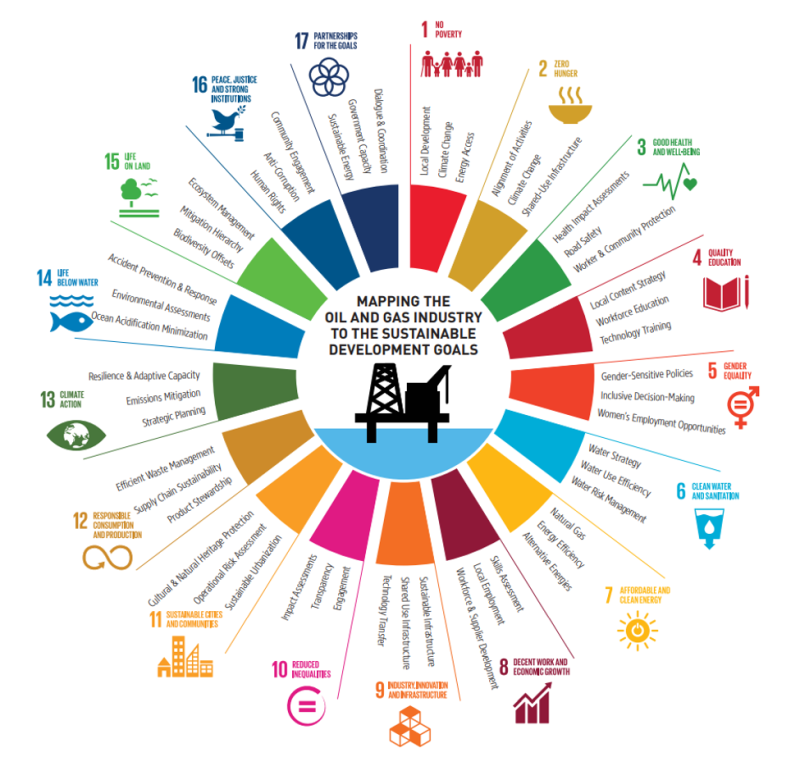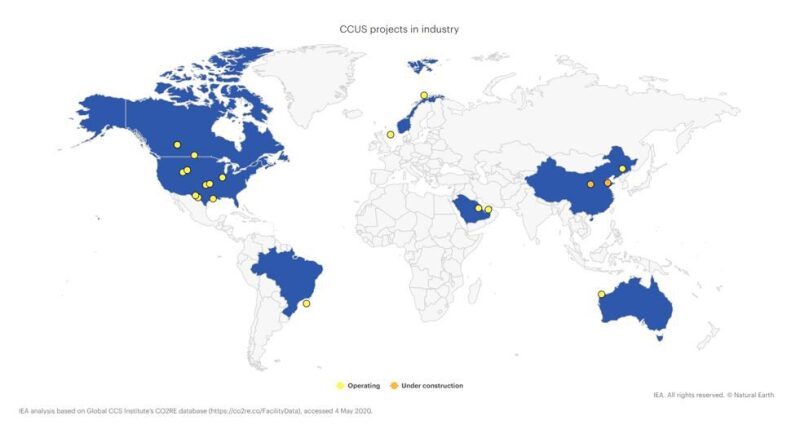An engineer working in the oil industry generally dedicates her or his academic years and first 5 to 10 years of professional career to mastering certain traditionally core technical and digital skills. The ability to assess, minimize, and offset environmental and social impacts now must be added to the list of core competencies.
Even in the current challenging macroeconomic environment, we must carefully consider the total environmental footprint, and the carbon emissions profile of our activities and use this as an additional criterion to optimize portfolio decisions. Focusing on “environmental” sustainability is critical for oil and gas “industry” sustainability.
The Next Cultural Revolution
Our essential role in providing the energy to keep the global economy moving requires us to pay special attention to the 17 United Nations Sustainable Development (SD) goals. The following are especially relevant:
- SDG #7: Affordable and Clean Energy
- SDG #13: Climate Action on Greenhouse Gas (GHG) Emissions
- SDG #14, #15: Life Below Water, and On Land
- SDG #6: Clean Water and Sanitation
Most of these topics are only lightly covered in most engineering curricula and have not yet been fully integrated throughout all organizations.

Fig. 1—17 UN Sustainable Development Goals and their applicability to Oil and Gas. Source.
Oil and gas professionals can add more value to their employer and society by exploring, learning about, and applying these SD concepts to their daily work. There are numerous case studies proving it is possible to reduce environmental footprint of projects and assets while also improving bottom-line profitability. Examples include reducing methane leaks across the value chain and the inclusion of renewable energy resources and battery-power backup to increase uptime and availability while reducing GHG emissions from upstream, midstream, and downstream facilities.
Additionally, opportunities are emerging, often in partnership with non-governmental organizations and governments, to go beyond net-zero impact to regenerate the ecosystems around our operations. Increasingly, our license to operate, our industry’s profitability, and the shareholder value we seek to generate depend on our success in these areas.
Oil is a natural part of the ecosystem, and carbon dioxide (CO2) is a natural part of our environment; however, extractive techniques and industrial use have created an environmental crisis of global proportions well out of balance with natural systems’ ability to offset or recover. Today, we are seeing increasing pressure from shareholders and institutional investors to do our important part to lead the energy transition. Initiatives such as the FSB Task Force on Climate-related Financial Disclosures will develop voluntary, consistent climate-related financial risk disclosures for use by companies in providing information to investors, lenders, insurers, and other stakeholders. Large asset managers such as Blackrock have explicitly stated that sustainability considerations are central to their investment decisions, and they assess the resilience of issuers across a range of carbon pricing scenarios (BlackRock). Attracting the investments essential to our industry increasingly requires a transformation of our business model and step-change improvements across every aspect of the oil and gas value chain.
Focus on GHG Reduction
Our role in leading the drive for more sustainable development of oil and gas goes far beyond GHG reductions, but it is one of the areas directly in our control. Importantly, GHG emissions are often just a proxy for the efficiency of a process or system. By increasing the efficiency of that system, profitability will be enhanced if the investment to improve efficiency comes with an attractive return.
According to the International Energy Agency, 15% of global energy sector GHG emissions are associated with oil and gas supply—about 5200 million tonnes (Mt). In exploration and production (E&P) activities, most emissions are associated with the venting, flaring, and fugitive emissions of natural gas, associated with the production of oil, which releases significant amounts of CO2 and methane (CH4) into the atmosphere. While CO2 and CH4 have significantly different GHG impacts, their combined effects can be aggregated as a single unit measured in tonnes of CO2 equivalent (tCO2e). Petroleum engineers have a central role to play in reducing GHG emissions and raising the awareness in their organizations about how this adds to sustainability goals beyond company borders.
According to the World Bank, 20% of global emissions are currently subject to carbon pricing regulation, ranging from $1 to $139/tCO2e with an average of $7/tCO2e. Even in jurisdictions where no such carbon tax is currently in effect, E&P companies are increasingly applying a cost to their future CO2e emissions in order to factor this into project economics.
Many energy companies publicly support the Paris Climate Accords referred to as COP21 (Conference of the Parties, United Nations Framework Convention on Climate Change), held in Paris in 2015, targeting less than a 2°C, and aspiring toward less than a 1.5°C, rise in global temperatures. Several supermajors, independents, service companies, and national oil companies have committed to reducing the carbon intensity of their operations and have set specific milestones describing their journey to carbon neutrality.
In order to blaze a trail to meet COP 21 targets, carbon capture use and storage (CCUS) has a critical role to play, but it won’t scale in time unless there is adequate policy support and we as an industry innovate to radically reduce costs. Few countries have pledged contributions, or included CCUS technologies in their National Determined Contributions. Subsurface storage capacity is enormous, so subsurface, wells, process engineering, and project management skills can play an important role in imagining and realizing a lower carbon future. Your creativity and fresh eyes are needed to make this work, and our industry is well-placed to lead.

Fig. 2—Yellow dots indicate locations of 19 currently operating CCUS projects in industry globally; two orange dots indicate additional Chinese projects under construction and planned to start-up by end-2021. Source.
The industry may also have a role in driving the adoption of nature-based solutions to offset our industry emissions. This may span many different sorts of solutions that leverage soils, trees, and other vegetation. How do we prepare to lead such projects or select from available options?
One of the leading inter-company initiatives helping to drive progress is the Oil and Gas Climate Initiative (OGCI). OGCI is a CEO-led consortium of 12 companies that have pledged to collectively invest more than $1 billion to accelerate the industry response to climate change. OGCI member companies explicitly support the Paris Agreement and its goals.
What other entirely novel pathways might we envision to restore the natural environment, and in doing so, create shareholder value and enhance our license to operate? What will competitiveness look like in our industry in 10 or 20 years from now? What new business models might emerge, new competitors, or new collaborations? How do we prepare students just starting their education to lead in such an environment? How can you serve as a potent catalyst for positive change?
Conclusions
The SPE Business, Management, and Leadership (BML) Committee produced this article to contribute to SPE’s collective efforts in raising awareness about the sustainable development of oil and gas, aiming to trigger personal reflection on how each and every one of us can seek to continually upskill and raise our game.
The oil and gas industry has an important role to play in leading the energy transition, as do you. Find BML resources, articles, and posts on the SPE website, The Way Ahead, SPE Forum, and the SPE LinkedIn group. You can find BML Webinars here.
There are many resources available for you to accelerate your professional development, including the following SPE Technical Sections: Carbon Dioxide Capture, Utilization, and Storage; Research and Development; and Sustainable Development.
The SPE Director of HSE and Sustainability, Johana Dunlop, launched a global multisociety movement, now called the SPE Gaia Sustainability Program. Gaia has since been adopted as the SPE sustainability brand. The program is gaining momentum and recruiting interested supporters and collaborators. We encourage you to attend the regular Gaia Talks on SPE Live and to learn about Gaia by reading the Oxford Energy Forum Series paper available here.
The Gaia movement is well under way and is motivating members and highlighting pathways and principles to guide collective oil and gas industry efforts. If you’re interested in learning more and getting involved, we suggest you initiate with the following three steps:
Step 1: Read about the UN Sustainable goals and organize SDG Workshops in your sections using the IPIECA Atlas and other materials.
Step 2: Calculate your own carbon footprint. Several options are available, such as Footprint App; Footprint Calculator; EPA Footprint Calculator; and WWF Environmental Footprint Calculator
Step 3: Register for SPE webinars and SPE Live Streams, and catch up on recently recorded events:
Quality of life has increased globally, fueled by the energy our industry proudly provides. However, some 800 million people still lack access to electricity or clean cooking fuels. All nations have the right to aspire to raise their standard of living. We have an important role to play to find innovative new ways to continue improving access to affordable energy for all while ensuring we live within our planetary boundaries (Stockholm University). The time is now to act with urgency and collective focus, supporting each other on this journey.
Opinions and statements in this article are only those of the authors and not those of their employers. The authors express their thanks to Johana Dunlop, Mark D. Zoback, and Asif Zafar for their insights and valuable feedback on this article.
Josh Etkind is Gulf of Mexico digital transformation manager at Shell, and is based in New Orleans, Louisiana.
Maria Angela Capello is an executive consultant for Kuwait Oil Company, based in Kuwait. She is the chair of the SPE BML Committee.
Florent Rousset is the managing director for GaffneyCline, based in Houston.

